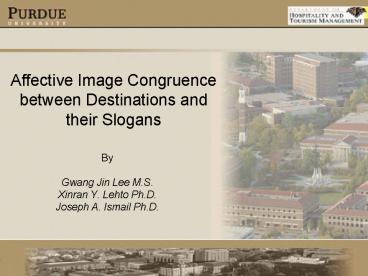Affective Image Congruence between Destinations and their Slogans - PowerPoint PPT Presentation
1 / 23
Title:
Affective Image Congruence between Destinations and their Slogans
Description:
Branding is applicable to tourism destinations (Pritchard and Morgan, 1998) ... d7: Chicago. d8: Los Angeles. d9: Dallas. d10: Boston. MDS (Destination Slogan) ... – PowerPoint PPT presentation
Number of Views:153
Avg rating:3.0/5.0
Title: Affective Image Congruence between Destinations and their Slogans
1
Affective Image Congruence between Destinations
and their Slogans
- By
- Gwang Jin Lee M.S.
- Xinran Y. Lehto Ph.D.
- Joseph A. Ismail Ph.D.
2
Study Background
- Destinations have been actively creating slogans
to build brand equity and connect emotionally
with consumers. - Destination slogans are powerful marketing tools
at various levels brand awareness and image - Examples of such attempt
- 100 New Zealand
- I Love New York
- Amazing Thailand
3
Research Question
- How are destinations and their slogans
- congruent or different from each others
- in the eyes of the consumers?
4
Study Objectives
- Understand consumers emotive responses to
destinations and their slogans - Measure congruence of emotive responses between
destinations and their slogans - Examine whether a slogan effectively presents an
implicative image of its destination
5
Definition
- Slogan is defined as
- a short phrase that communicate descriptive or
persuasive information about a brand (Supphellen
and Nygaardsvik, 2002) - an extremely efficient, short-hand means to
build brand equity (Keller, 1993) - a useful hook or handle for consumers to
understand the meaning of the brand and can
facilitate brand differentiation by giving a
brand an identity (Keller, 1993)
6
Destination as Brands
- Branding is applicable to tourism destinations
(Pritchard and Morgan, 1998) - Tourist destination brands are considered more
complex than generic consumer brands - (Morgan, Pritchard and Pride, 2002)
- Lack of control over the marketing mix
- Limited budgets
- Political issues in destinations
7
Classical Brand Components
Slogan Brand Image Brand Association
8
Destination Slogan and Image
- Slogan should capture the emotional image of the
destination (Greco, 2004) - Importance of consistence between content of
slogan and stated purpose of destination brand
(Supphellen Nygaasrdsvik, 2002)
9
Destination Image
- Definition
10
Components of Image
Destination Image
11
Components of Image
Destination Image
Cognitive Image (perceived fact) Scenery,
Climate, Nightlife, Historic Sites, Beaches,
Architecture
Affective Image (emotional feeling) Pleasant,
Exciting, Angry, Annoying, Gloomy, Depressing
(Proshonsky, Fabian, and Kaminoff, 1983 Russel,
Ward and Pratt,1981 Baloglu and Brinberg,
1997)
12
Circumplex Model of Affect
(Russel and Pratt ,1980)
13
Methodology
- The online survey
- 265 domestic college students from a major
mid-western university - (Male 48.6 Female 51.4 , Median Age
21) - 5 Popular U.S Cities 5 Corresponding States
- Total 10 Slogans of cities and states
14
Sample Destinations and Slogans
15
Measurements
16
Procedure
- Demographic Questions
Section 1
Affective Response to Slogans (Randomly Ordered
10 Questions)
Section 2
Random Sequence
Affective Response to Destinations (Randomly
Ordered 10 Questions)
Section 3
17
MDS (Slogan)
- S1 Wide Open
- S2 Mile after Magnificent Mile
- S3 Find Yourself Here
- S4 Its like a Whole Other Country
- S5 Make It Yours
- S6 What Happens Here, Stays Here
- S7 City of the Big Shoulders
- S8 (The City)s the place
- S9 Live Large. Think Big
- S10 The Hub of the Universe
18
MDS (Destination)
- d1 Nevada
- d2 Illinois
- d3 California
- d4 Texas
- d5Massachusetts
- d6 Las Vegas
- d7 Chicago
- d8 Los Angeles
- d9 Dallas
- d10 Boston
19
Distance of Affective Images between Slogan and
Destination
S1 Wide Open S2 Mile after Magnificent Mile S3
Find Yourself Here S4 Its like a Whole Other
Country S5 Make It Yours S6 What Happens Here,
Stays Here S7 City of the Big Shoulders S8 (The
City)s the place S9 Live Large. Think Big S10
The Hub of the Universe
d1 Nevada d2 Illinois d3 California d4
Texas d5Massachusetts d6 Las Vegas d7
Chicago d8 Los Angeles d9 Dallas d10 Boston
20
MDS (Destination Slogan)
21
Discussions and Conclusion
- Applies the Circumplex Model of Affect to study
of destinations and slogans - Provides a visual comparison of the relative
perceptual positions of destinations and slogans - Enables destination marketers to understand that
slogans should be designed to reflect emotive
image of destination - Provided destination marketers a means for
current and future testing of destination slogans
22
Limitation
- Student sample
- Particular area in mid-west city
23
Thank you
- Q n A































